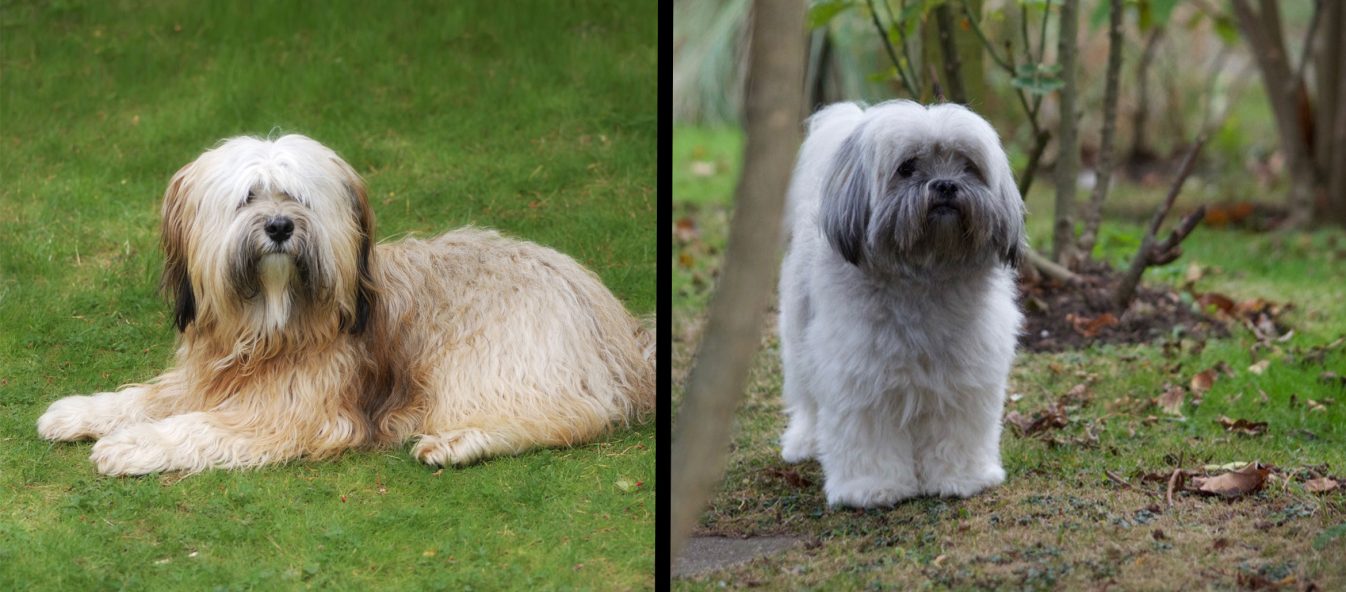Top left image: File ID 9823031 | © Manfredxy | Dreamstime.com
The History
The Tibetan Terrier is a purebred medium sized dog which looks very much like a large Lhasa Apso. We’ve discussed the origins of the Lhasa Apso previously, but what about Tibetan Terriers? These animals were previously known as the “Holy Dogs of Tibet”. Their origins date back thousands of years and it’s believed they are related to the Lhasa Apso, Shih Tzu, and Tibetan Spaniel. Originally Tibetan Terriers were given as gifts by the monks as a gesture of goodwill as they believed this would promote good luck. They were used as watchdogs and companions. In 1922 the first Tibetan Terrier was brought to Europe by Dr Greig. The Tibetan name given to the breed was Tsang Apso which roughly translates to bearded dog from the province of Tsang. It was also known by the name Dhoki Apso meaning outdoor bearded dog.
What are the main differences?
The Lhasa Apso and Tibetan Terrier can look very similar in appearance. They have a similar frame and as we’ve already discussed both originate from Tibet. There are however a few ways to distinguish between the two breeds that we will now explore. Hopefully, this will help you to identify one from the other.
Size and weight
The most obvious difference between the two breeds is the size and weight. The Tibetan Terrier is a powerful dog, much larger than a Lhasa Apso. This is very apparent when you compare the two breeds side by side. The Tibetan Terrier has a square stance, with a well-muscled body that stands several inches taller than the average Lhasa. The Tibetan Terrier would be classed as a small/medium-sized dog whereas the Lhasa Apso is more obviously a small dog.
Physical features
Tibetan Terriers have a longer shaped head. Being the larger of the two breeds, the Tibetan Terrier also has longer legs and is more powerfully built. It has V-shaped ears and a strong medium length muzzle with a well developed lower jaw and a black nose. The eyes are large, dark and set quite far apart. By contrast, the Lhasa Apso is a smaller and more delicate dog with a less pronounced muzzle. The Tibetan Terrier also has a unique physical trait that distinguishes it from other comparable breeds. Its feet are very large and flat relative to their body. This would have provided them with better traction in snowier mountainous climates.
What are the main similarities?
When these breeds first arrived in the UK in the 1920s they were not separate. The Kennel Club first classified both the Lhasa Apso and Tibetan Terrier as Lhasa Terriers. It wasn’t until the 1930s that the two breeds were separated. There is now much better clarity on their individual identities but there are good reasons why people originally thought they were all one and the same. There are an array of similarities that arise from their Tibetan origins. We’ll briefly cover a couple of them below.
Hair and coat
Both the Tibetan Terrier and Lhasa Apso have a protective double coat. The undercoat is quite wooly and rather soft which would help them keep warm in the cooler climates of the Tibetan mountains. The outer coat comprises of longer, fine hair from which you can see individual strands much like human hair. The coat is fast growing and will require plenty of grooming attention so bear this in mind if you’re considering either breed.
Personality
The temperament and personalities of both the Tibetan Terrier and Lhasa Apso are well aligned. Both have excellent watchdog skills and have intelligent hearing. In other words, they’ll generally only bark when something suspicious is going on. They’re also great companion dogs who are fiercely loyal to their owners. Both dogs are likely to be suspicious of new people and may take a little longer than usual to form friendships. Once you’ve earned their trust, you’ll have made a lifelong friend. They generally take to training very well but they are stubborn dogs that need positive reinforcement to guide them into adulthood.
Important information
Information provided by LhasaLife should not be taken as professional veterinary advice or clinical advice. It is important to consult a licensed veterinarian for any health concerns or issues with your pet. The content of the article What is the difference between a Tibetan Terrier and a Lhasa Apso? should not be used as a substitute for veterinary care, or treatment advice for you or your pet, and any reliance on this information is solely at your own risk.
This article may contain affiliate links, meaning we may earn a small commission at no extra cost to you if you purchase through these links. Affiliate links do not necessarily imply an endorsement of the product by LhasaLife. However, we only share products we believe could be helpful to you and your beloved Lhasa Apso. Your support helps us keep the website running and full of useful content.




Leave a Comment